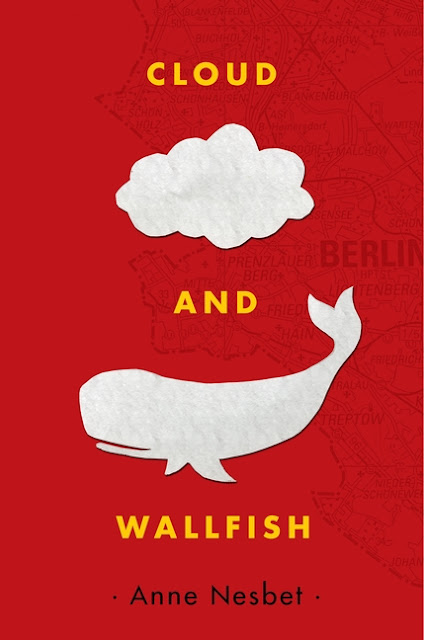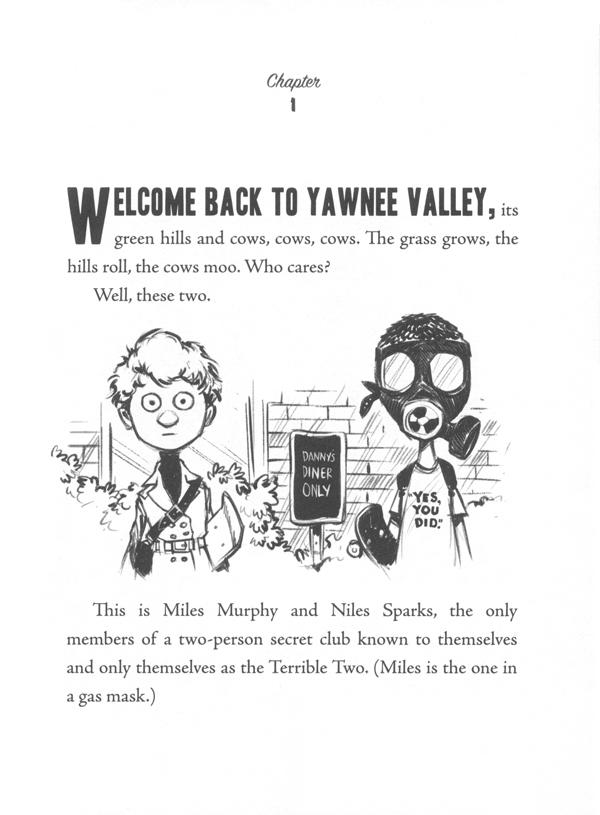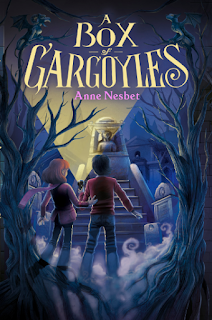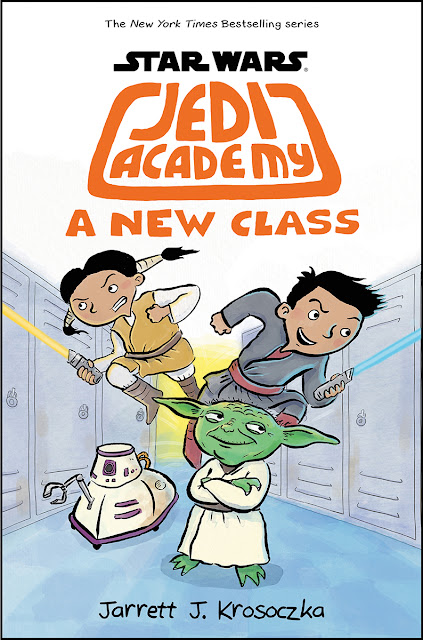new posts in all blogs
Viewing: Blog Posts Tagged with: BRL4, Most Recent at Top [Help]
Results 1 - 7 of 7
How to use this Page
You are viewing the most recent posts tagged with the words: BRL4 in the JacketFlap blog reader. What is a tag? Think of a tag as a keyword or category label. Tags can both help you find posts on JacketFlap.com as well as provide an easy way for you to "remember" and classify posts for later recall. Try adding a tag yourself by clicking "Add a tag" below a post's header. Scroll down through the list of Recent Posts in the left column and click on a post title that sounds interesting. You can view all posts from a specific blog by clicking the Blog name in the right column, or you can click a 'More Posts from this Blog' link in any individual post.

I reviewed and really enjoyed Anne Nesbet's debut novel, The Cabinet of Earth. It was exciting to read a middle grade fantasy novel set in Paris and I found the magic that Nesbet created for this story exciting and out of the ordinary. Nesbet followed with A Box of Gargoyles, a companion to her first book, then The Wrinkled Crown, another fantasy with the feel of a traditional fairy tale, albeit one with political undertones. It surprised me to find that Nesbet's new book, Cloud and Wallfish, is set in East Germany in 1989 and centers around the hard won friendship between an American boy with a paralyzing stutter and a curious girl who has been sent to live with her grandmother. Like what I imagine life in the German Democratic Republic prior to the fall of the Berlin Wall must have been like, Cloud and Wallfish is a quiet, secretive book that requests patience from readers. This patience will be rewarded, like the page turn that reveals the meaning to the title of this marvelous book, but some questions will never be answered.
Cloud and Wallfish begins in Oasis, Virginia in May of 1989. Noah Keller has almost finished fifth grade when his parents pick him up from school and completely turn his life upside down. Everything with his name on it is thrown into a trashcan at a rest stop on their way to the airport. They are headed to East Berlin, where Noah's mother has been given the opportunity to study the educational system in East Germany and finish her doctoral dissertation titled, "Differential Approaches to Elementary Education for Children with Special Speech-Production Impediments in East and West." This dissertation is especially personal for Noah and his mother because Noah stutters and has often been a guinea pig for his mother and her research. Noah also has a photographic memory, although he has not revealed this ability to his parents.
Noah's mother gives him a list of nine rules that he must adhere to strictly now that their "adventure" has begun, the first of which is, "They will always be listening and often be watching. Don't forget that." She also tells him that they are all changing their names, handing him a photo album filled with "memories" from a city they never lived in. Noah's dad also tells him that he was born in November and not March as he had always believed, sending him spiraling even further. Nesbet, by way of Noah's father, helps Noah cope with finding out that he isn't the person he thought he was, and that he is also being required to become a new person, in a humorously philosophical way that made me stop and think about identity,
Names change all the time. Some people change names when they get married, Some people write books under a pseudonym. Some people just always wanted to be called Rainbow Stormchaser, and one day they decide to make it so. Some people emerge from their wild teenage years and decide it's time to settle down to a quiet life in Oasis, Virginia, under different names entirely -
As an adult reading Cloud and Wallfish, there were so many moments that made me stop and think, and turn to Wikipedia, or my husband who is a history teacher and who also, like Nesbet, visited East Berlin as an exchange student (in fact, Nesbet, who is a professor at University of California Berkeley returned to the GDR in 1989 to work on her own dissertation). It was clear to me from the start that one or both of Noah's parents are spies (although Noah's stay-at-home dad insists that he is writing a novel about a mink farmer, he even puts locks his manuscript in the safe in their East German apartment every night), but I hope that young readers will come to this realization over the course of the novel along with Noah as he comes to suspect this himself.
Once in East Berlin, Noah's (now Jonah Brown) life comes to a grinding halt. Not only does he have to adhere to the nine rules, almost all of which include some form of not talking to anyone at any time, he is not allowed to go to school. Things do look up when he meets the girl living downstairs. Claudia, who is staying with her grandmother while her parents visit Hungary, is kept from talking to him, but she does get the chance to tell him that they are both changelings, strangers in this world and needing to get back to where they came from before they are forgotten. The two find their own coded ways to communicate, in the middle of country that is rife with codes and secret communications. One of my favorite, unforgettable things in Cloud and Wallfish is a communication the two share as they pass a map of Berlin back and forth. On this map, West Berlin is a blank, white blob amidst the streest of East Berlin and the two slowly begin drawing the intricate world of the changelings that they need to return to in this space.
The true climax of Cloud and Wallfish comes almost at the end of the novel, but "Secret Files" that Nesbet includes at the after each chapter (which are really non-fiction glimpses into this time in East Germany, with translations of newspaper articles and speeches and more, illuminating further the strange dystopian world that existed in Europe, in my lifetime) help to build the tension. I don't want to give too much away, but a tragedy with Claudia's parents and a secret revealed to Noah propels the two children into a dangerous situation just before the fall of the Berlin Wall. Nesbet's epilogue, which visits Claudia some years later, had me tearing up, in a good way.
Cloud and Wallfish is an amazing book that prompted me to learn more about the world that I live in. It is also a book that will require perseverance and dedication from readers, but also one that will reward this hard work. I hope that teachers and parents will embrace Cloud and Wallfish and read it out loud, a really great way to hook kids on a book they might not pick up or a book they might not stick with. My twelve-year-old son has heard me and my husband talking about this book and I think he is almost ready to give it a go, but of course I can't suggest that he read it...
Another fantastic book set in East Germany, 1961, beginning just as the wall goes up:
More books by Anne Nesbet
Source: Review Copy

Jeffrey Brown authored the first three books in the Jedi Academy series, two of which I enthusiastically reviewed here. This trilogy is HUGELY popular in my school library and a fantastic alternative to Diary of a Wimpy Kid. Before that, Brown wrote a trilogy of Darth Vader, a comics series that imagines Vader's life as father to Luke and Leia. Brown's new series debuted in August and features prehistoric siblings Lucy and Andy as they deal with typical kid stuff while also being filled with scientific information and facts about pre-history.
Jedi Academy was too good to let go, and quite smartly, Scholastic has tapped Jarrett Krosoczka, author of the Lunch Lady series of graphic novels. Jedi Academy: A New Class finds young Victor Starspeeder making a midyear transfer from the Jedi Academy at Obroa-skai, where he has had a series of mishaps to the Jedi Academy at Coruscant. Victor decides that he is going to start keeping a journal of his time at Jedi Academy because that is what his father, who died when Victor was a baby, did. 
The Jedi Academy has its own challenges, starting with Christina, Victor's big sister, who already goes there. She tells him in no uncertain terms that once they are at school, they are strangers. Navigating the new school on his own, Victor is swayed by Zach, and older student, who turns out to be a bully and a prankster with his own agenda. He also gets stuck with Artemis, an asthmatic kid in a black hooded cloak who just might be a Sith. Victor tries to make friends, impress a girl, and get his special project on the planet Endor completed while also trying to stay out of trouble and keep Zach from getting him kicked out.

Krosoczka hits all the right notes in Jedi Academy: A New Class, continuing and updating features that Brown introduced in the first three books like handwritten notes between characters, school schedules and pages from the school newspaper, including an advice column by Ms. Catara, the school guidance counselor who is also a Gungan. Krosoczka also creates a couple new twists, including the Galaxy Feed, which is a social media type feature that pops up on a tablet like device, and a page of comic strips that look at classics like Family Circus, Peanuts and Garfield through the lens of Star Wars. I especially liked, "Huttfield," in which Jaba the Hutt is the lazy, food loving star of the strip.
While I love that this series continues on (and I hope that, after another three books a new author/illustrator takes on this challenge) and am thrilled that I have more of these books to offer students, for me, Krosoczka's take on the academic world of the young Jedi lacks a bit of the depth, heart and humor that I found in Brown's books. But hey, I'm pretty sure I'm not the target audience for these books...
Source: Purchased
When Ms. Bixby announces that she is very sick and won't be able to finish out the last weeks of the school year (or even finish the last 20 pages of the class read aloud, The Hobbit) Brand, Steve and Topher decide that they want to give her a proper last day. That's the nutshell summary of John David Anderson's newest novel, Ms. Bixby's Last Day. I knew that this wasn't going to be an easy read, but there was no way I was not going to read (and love) Ms. Bixby's Last Day, tissue box by my side. Anderson's book is a surprise, a delight and a reminder of why I work with kids, how a teacher (or other thoughtful adult) can make a powerful, even if seemingly small at the time, impact on a child's life and how valuable it is to be reminded of this by a work of art. But will kids want to read it?
That's what I wondered as I pored over every page - exactly who would I recommend this book to? One thing that I especially love (among many) about Ms. Bixby's Last Day is the fact that the story is told by three narrators, all sixth grade boys. In this age of (slouching toward) equality, it is a challenge to find a middle grade novel featuring all boy or all girl protagonists. The formula, for fantasy, anyway, is always boys and girls, with boys usually as the main character - think Harry, Ron and Hermione or Percy, Grover and Annabeth. It's a genuine treat to hear the voices of three different boys over the course of 300 pages. Anderson has created three characters, each of whom, to varying degrees, has things going on at home that make Ms. Bixby's unique attention so meaningful. Topher is a gifted artist who misses the way his family was before the birth of his little sister and his mom's return to the workforce. Steve, who once memorized every country (and capital, population and official language) for fun, feels inferior to his older sister, a perfectionist who meets their parents's high standards. Then there is Brand, the quiet, driving force of this trio and the feat they try to pull off while ditching school one Friday. Raised by his dad, Brand's life changed drastically when his father was paralyzed by an accident at work and his will to get back on his feet, metaphorically and literally, disappeared.
Topher, who has classified teachers into six categories, puts Ms. Bixby into the "Good Ones" column - the kind of teachers who you "find yourself actually paying attention in class, even if it's not art class. They're the teachers you actually want to fo back an say hi to the next year. The ones you don't want to disappoint." Ms. Bixby has a talent for recognizing, valuing and nurturing what is special in her students and also for making them think. When the class is deprived of the chance to say goodbye to Ms. Bixby because the treatment for her pancreatic cancer has been pushed up, Brand, Steve and Topher decide to ditch school and take the bus to the hospital to see her. Armed with a special knowledge of how Ms. Bixby would spend her last day on earth (this was a writing prompt she gave her students, one of whom asked her what she would do) the boys carry backpacks, cash, a picnic blanket, a wine glass and more with them as they stop to try to buy the things they need for the special day and meet with obstacles they never saw coming. As Ms. Bixby's Last Day unfolds, each boy narrating part of their odyssey to make it from school to the hospital downtown, Anderson reveals things about their lives and their relationships with Ms. Bixby. He also throws in some tension between the friends along with more than a few hilarious scenes and suspenseful twists as well. Ms. Bixby's Last Day is, as Anderson says in his acknowledgements, a quiet book. There is more reflection than action, but Anderson's story telling style is masterful, with hints to meaningful moments that are revealed powerfully in later pages or chapters. Although a quiet book, Ms. Bixby's Last Day is always moving forward with Steve, Brand and Topher as they make their way to room 428 in St. Mary's Hospital.
So who will I recommend Ms. Bixby's Last Day book to when school starts up again in August? I'm still not sure. But, during the last week of June I was sorting discarded library books to give away and a coworker's daughter, who just finished 7th grade and is quiet and a bit shy, was helping me. I asked her what she likes to read and she responded adventure stories, real life, no fantasy. I pulled a few books off the shelf for her and we sat and read, waiting for people to come to the book give away. A couple of middle school boys zipped by on their bikes and stopped to talk to me, getting a little goofy when they saw my helper. They circled around on their bikes showing off and my helper and I talked about how dumb middle school boys can be. Then I told her about the book I was reading, Ms. Bixby's Last Day, and how it started off with sixth grade boys talking about cooties and being goofy and how they wanted to visit their sick teacher. Later, as we were packing up the leftover books, she surprised me (mostly because of our discussion about dopey boys) by asking if she could borrow my copy of Ms. Bixby's Last Day. I gave her my Advance Readers Copy with the promise that she send a note to work with her mom in August telling me how she liked it.
Source: Review Copy
A year ago saw the debut of The Terrible Two by Mac Barnett, Jory John and illustrator Kevin Cornell. A standout for being laugh out loud funny (not as common a trait in kid's books as you might expect), The Terrible Two began the story of Miles, new kid in Yawnee Valley and master prankster, and his nemesis, Niles, the rule-following, goody-two-shoes, sash-wearing School Helper. The Terrible Two took a terrific turn when (SPOILER ALERT) it turned out that the angelic Niles was actually the secret prankster challenging Miles's status. The two teamed up, repeated the prankster's oath and shared a secret handshake before going on to pull off the greatest prank at Yawnee Valley Science and Letters Academy ever against their favorite target, Principal Barkin. Niles, Miles, Principal Barry Barkin, and his entitled son Josh are back in The Terrible Two Get Worse, along with Principal Barkin's father, retired Principal Bertrand Barkin. 
The new school year seems to be off to a great start for the Terrible Two, who begin by smearing Limburger cheese all over the undercarriage of Principal Barkin's yellow hatchback as he enjoys Sunday brunch with Josh at Danny's Diner. The pranks continue into the school year until Bertrand Barkin decides to put an end to it by forcing his son out of his job and returning to his old job. Even worse, Bertrand Barkin, who sets up a giant sign to show how many prank-free school days have passed, has the personal motto, "It is only a prank if we react." As Principal Barkin the elder continues to refuse to react to Niles and Miles's pranks, the Terrible Two begin to get desperate. Niles even has an existential crisis that causes him to vomit and retreat to his room for several days. But, the Terrible Two are not down for long, and they come up with a crazy plan to take down Bertrand Barkin that includes expanding the Terrible Two to Three...

As before, The Terrible Two Get Worse is hilarious and hard to put down. What I love about Barnett and John's series is that the humor is smart. What other kid's book can throw out concepts like Chekov's Gun and Occam's Razor? And, happily, the presence of two items that seem to be Chekov's guns (a spool of thread and the suspenders-belt combo worn by Bertrand Barkin) are explained by the end of the book. And, in a wry and kind of eerie scene, Ms. Shandy, the social studies teacher, unveils a lesson during which the class will be living in a totalitarian state for two days, divided into groups that will create propaganda and samizdat in the style of Alexei Khvostenko. Of course Miles, Niles and their pal Holly Rash, school body president and a character I hope we see A LOT more of in the next book, decide to create samizdat, that is, until Principal Bertrand Barkin shuts the project down. Also, Cornell's illustrations that show Barry Barkin as he ticks off items on his list of projects to complete while he is unemployed, which begins with, 1. Start a list of projects, 2. Discover who you truly are, through projects.
I can't wait to see what the next book in this fantastic series brings! Until then, I will thoroughly enjoy discussing the pranks of the Terrible Two with my students, who love these books!
Be sure not to miss the equally hilarious website , which you could spend a serious amount of time pouring - and laughing over. The shop, where you can buy the books, of course, also offers up the Brooklyn Bridge for purchase! There is also a "plog," a blog of pranks, a video of a commercial for the book in Greece and covers of the books in translation in many languages!
Source: Review Copy

By: Tanya,
on 7/1/2015
Blog:
Children's Book Reviews and Then Some
(
Login to Add to MyJacketFlap)
JacketFlap tags:
Historical Fiction,
Award Winner,
Reading Level 4,
Real Life Boy Stories,
Real Life Girl Stories,
Winter Holiday Stories,
aauthor: Carlson,
GRL4,
BRL4,
HSRL4,
Add a tag
Written in 1958 and winner of the Newbery Honor, The Family Under the Bridge is the story of how an old hobo named Armand, who wants nothing of homes, responsibility and regular work, ends up with all of these as well as a family of children.
Set in Paris, France in a time when hobos were more like wandering gypsies than the people living on the streets these days, the story follows Armand

By: Tanya,
on 6/29/2015
Blog:
Children's Book Reviews and Then Some
(
Login to Add to MyJacketFlap)
JacketFlap tags:
Reading Level 4,
Real Life Boy Stories,
School Story,
Real Life Girl Stories,
short books - BIG IDEAS,
Armchair Traveling,
aauthor: Morgentstern,
GRL4,
BRL4,
Add a tag
First reviewed on 11/16/08, Secret Letters from 0 + 10 left a great impression on me. A wonderful, quiet story, Morgenstern's writing is superlative. Your children will remember this book long into adulthood.
Secret Letters from 0 to 10 by Susie Morgenstern is a gem of a book. It turned up on the shelves of the bookstore one day and I was drawn to the cover, its length and the fact that is
The Terrible Two is the first book in new series created by authors with serious pedigrees in kid's books and humor, Mac Barnett and Jory John and perfectly, illustrated by self-proclaimed "mediocre illustrator and humorist," Kevin Cornell. As a parent, bookseller, composer of personalized book lists and librarian, I get asked for funny books all the time. Unfortunately, writing (good)


















